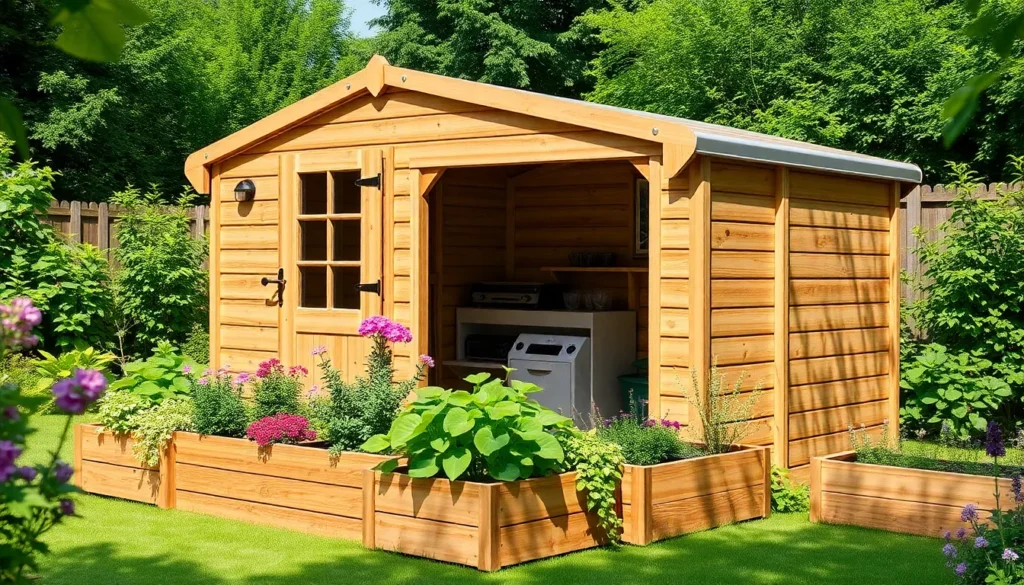In a world where “going green” isn’t just a trend but a necessity, sustainable living builders are the superheroes we didn’t know we needed. They swoop in with eco-friendly materials and innovative designs, transforming ordinary homes into energy-efficient havens. Who knew saving the planet could look so stylish?
Table of Contents
ToggleOverview of Sustainable Living Builders
Sustainable living builders play a vital role in promoting environmentally friendly practices. These professionals focus on constructing homes that minimize negative impacts on the environment. Emphasis on energy efficiency often leads to reduced utility costs for homeowners.
These builders typically utilize renewable resources, such as bamboo or reclaimed wood, ensuring materials have minimal ecological footprints. Innovative designs frequently incorporate features like solar panels and rainwater harvesting systems. Such technologies help create self-sufficient residences.
Collaboration with architects and designers enhances the effectiveness of sustainable homes. Green certifications, such as LEED, provide third-party validation of the builder’s commitment to sustainability. Builders may also prioritize efficient insulation and smart home systems, further reducing energy consumption.
Consumer awareness of environmental issues has spurred demand for sustainable living builders. He or she recognizes that potential buyers prefer eco-friendly homes, driving the industry to evolve continually. Access to information on building trends allows homeowners to make informed decisions.
Investments in sustainable building not only benefit the planet but also enhance property values. Market research shows that homes built with sustainability in mind often command higher resale prices. Therefore, sustainable living builders become essential not only for environmental well-being but for economic viability as well.
Key Features of Sustainable Living Builders
Sustainable living builders focus on creating homes that prioritize environmental responsibility and efficiency. Their approach encompasses several key features that define their commitment to sustainability.
Eco-Friendly Materials
Sustainable living builders often utilize eco-friendly materials to minimize environmental impact. Bamboo, reclaimed wood, and recycled steel represent popular choices that reduce resource consumption. Natural insulation materials such as cellulose or sheep’s wool enhance energy conservation while improving indoor air quality. These materials not only lessen carbon footprints but also promote healthier living environments for homeowners. Increased durability results from selecting high-quality resources, ensuring that structures withstand the test of time.
Energy Efficiency
Energy efficiency remains a cornerstone of sustainable living homes. Builders incorporate advanced insulation, energy-efficient windows, and smart thermostats to optimize climate control. Installing solar panels allows homes to generate their own energy, further reducing dependence on fossil fuels. Additionally, energy-efficient appliances contribute to lower utility costs while minimizing energy waste. By focusing on these aspects, sustainable builders create cost-effective solutions that elevate homeowners’ quality of life.
Innovative Designs
Innovative designs play a vital role in sustainable building practices. Open floor plans promote natural lighting, reducing reliance on artificial illumination. Green roofs and living walls enhance aesthetics while contributing to biodiversity. Furthermore, flexible spaces allow for multifunctionality, adapting to varying lifestyle needs. These creative approaches merge style with functionality, showcasing that eco-friendly living can be visually appealing. Sustainable living builders consistently push boundaries, ensuring that innovation meets environmental accountability.
Benefits of Choosing Sustainable Living Builders
Sustainable living builders provide numerous advantages that support environmental responsibility, financial savings, and healthier living conditions.
Environmental Impact
Builders focused on sustainability significantly reduce the carbon footprint of their projects. They incorporate eco-friendly materials like bamboo and reclaimed wood, which minimize depletion of natural resources. Features such as solar panels and rainwater harvesting systems contribute to self-sufficient homes, further decreasing reliance on external energy sources. Using renewable resources leads to a decrease in pollution, promoting a healthier ecosystem. Green certifications, such as LEED, validate these builders’ efforts and commitment to sustainable practices.
Cost Savings
Homeowners often experience reduced energy bills when utilizing sustainable living builders’ designs. Energy-efficient windows and advanced insulation minimize heating and cooling costs throughout the year. Although upfront costs might be higher, energy savings accumulate over time, leading to lower overall expenses. Investments in renewable technology like solar installations often provide financial incentives, such as tax credits. Higher resale values for sustainably built homes further enhance economic benefits, making sustainable living a wise investment choice.
Healthier Living Spaces
Sustainable living builders create environments that prioritize occupant health and well-being. By using natural insulation materials and non-toxic finishes, they reduce indoor air pollutants and improve air quality. Sustainable homes often feature ample natural light and open spaces, contributing to psychological well-being. Smart home technology helps maintain optimal temperatures and humidity levels, further enhancing comfort. These builders emphasize holistic living, resulting in spaces designed for healthier lifestyles.
Notable Sustainable Living Builders
Zero Energy Project specializes in constructing homes that produce as much energy as they consume, emphasizing energy independence. This builder integrates solar technology into designs, which enhances sustainability.
Green Homes America focuses on health and efficiency. Their homes utilize advanced air filtration systems and natural building materials, ensuring comfort and wellness for occupants.
EcoBuilding, known for its modular designs, promotes minimal waste and faster construction. This approach not only reduces environmental impact but also allows for customization to meet client needs.
Reclaimed Wood Exchange excels in using salvaged materials. Their projects showcase the beauty of recycled wood while minimizing the demand for new resources.
Sagi Construction prioritizes durable materials and designs that adapt to climate changes. This forward-thinking strategy ensures resilience and enhances energy efficiency across various environments.
BrightGreen Homes constructs energy-efficient residences, emphasizing local materials and sustainable practices. Their commitment to environmental stewardship translates into lower utility costs for homeowners.
Blueprint Sustainable Homes attracts clients looking for eco-friendly solutions through its innovative designs. They create stylish, sustainable dwellings that meet both aesthetic and functional needs.
Each of these builders contributes significantly to the sustainable living movement, showcasing practices that not only protect the environment but also provide healthier living options for families. These companies lead the way in demonstrating how eco-friendly construction aligns with modern living expectations.
Sustainable living builders are paving the way for a greener future by integrating eco-friendly practices into home construction. Their commitment to using renewable resources and innovative designs not only benefits the environment but also enhances the quality of life for homeowners. As demand for sustainable homes continues to rise, these builders are proving that sustainable living can be both stylish and functional.
Investing in homes built by these professionals offers long-term savings and healthier living conditions while contributing to the overall well-being of the planet. The future of homebuilding lies in the hands of those who prioritize sustainability, making it an essential choice for environmentally conscious consumers.










